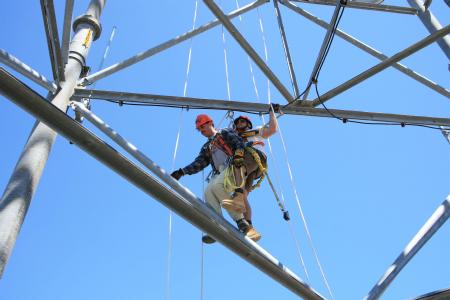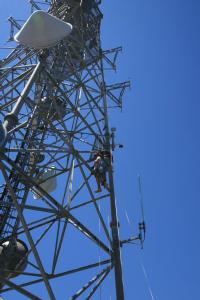|
December 10, 2007
Tower Rescue Practice
By Jim Hale, HPWREN staff
Acrophobia (from Greek Acro meaning "summit") is an extreme or irrational
fear of heights. A condition I seriously suffered before coming on with
the High Performance Wireless Research and Education Network. More often
than not, no matter which link along the HPWREN network you choose, it
probably begins and ends high on a microwave tower. Making the
installation, repair and maintenance of the antennae and equipment that
make this network function, is serious and sometimes dangerous work.
Before any HPWREN Tower Climbing is done, all participants and
collaborators are issued Certified Fall Arrest Equipment such as FA
Harnesses and FA Lanyards, as well as in depth training from an OSHA
standards qualified Instructor. All regular HPWREN team members are OSHA
standards certified climbers and High Safety Standards are maintained by
regular training and rigorously supervised "on tower" practice sessions.
Though the work at tower sites is inherently risky, the risk is often what
makes the work so interesting. Many benign circumstances can cause
situations that will require a climber to need rescue from high atop a
tower. A climber losing grip of a wrench and dropping it on a climber
below, a missed step or worse, a lightning strike on a day with no clouds
in the sky, can cause a rescue to be required. It is not necessary for a
climber to be rendered unconscious to require rescue. An injured hand or
foot, maybe an injured finger can prevent a climber from descending a
tower on their own.

|
A smiling Pablo Bryant is acting victim in this practice,
as rescuer Bud Hale lowers him safely to the UCSD Structures Lab
floor. Both Climbers are connected to two ropes. One rope is
connected to a Fisk Descender. The Climber uses the Fisk to
control their descent. The additional rope is connected to the
climber by a Rope Grab. Should the climber become disconnected
from his primary lifeline or the lifeline break. The rope grab
will clamp on the additional line and prevent them from falling.
|
HPWREN climbers are often better prepared and equipped for many tower
rescues than are most emergency first responders. As a result of team work
and attention to individual limitations that no rescue has, to this date,
ever been needed, "Tower Rescue Kits" are prepared and conspicuously
visible at all at all tower climbing situations, as well as the regular
climbers are well practiced in "Tower Rescues" and should an actual rescue
ever be required, there is a good chance that the victim of an accident
may have worked together with their rescuer in a practice rescue and is
confident in their ability to get them to safety. As well as practicing
the techniques of bringing someone down from high up a tower, HPWREN
climbers are also experienced, well practiced victims.
During our rescue practice events, we review climbing standards, but
mostly, we put time in practicing and familiarizing ourselves on our
rescue kits. HPWREN has two such kits. As the Climbing and Rescue
Instructor, one I keep with me in my truck, as my truck is likely to be at
all climbing events. Since I have the rescue gear, I'm guaranteed the best
parking spots. Each kit contains 220 feet of 12 mm kern mantle rope, a rope
terminator to connect the rope to a tower or structure, 3 locking
carabiners and a Fisk Descender.
|
Left: The Fisk Descender. Climbers use this device to control
the rate of descent down a lifeline and allows a climber to
"Tie Off", stopping their descent and freeing both hands for
task performance.
Right: The rope terminator. Tying loops and
knots into ropes can reduce a ropes breaking strength. A
Terminator and Tie-Off adapter strap secures the lifeline to a
structure reducing wear on the rope and retaining the greatest
working strength.
|

|
There are several types of descenders available for this type of use.
Popular with rescue services are the Rack style devices or Rescue8 device.
Both fine units. I don't teach the Rack as it has moving parts and is a
little complicated to rig, especially in the haste of a rescue. I have
exposed HPWREN climbers to the Rescue8. It is rigged similar to the Fisk,
but also like the Rack style it is not as simple to tie off to hold your
descent. The Fisk Descender on the other hand is simple to rig and has no
moving parts. The multiple wraps offer greater contact with the rope
providing a high degree of resistance without the rope coming in contact
with itself, decreasing rope wear.
|
Pablo Bryant, having descended from the 80 foot start of the course,
"rescues" Dan Zieber from the 40 foot level. The tower provides numerous
obstacles to increase the value of the training and presenting
valuable experience whether acting as the victim or the rescuer.
|

|
During approximately the past year, HPWREN associates have had
two such practices. Dr. Chris Lathem and Bob Parks of the Jacobs
School of Engineering hosted our practice at the Structures Lab,
providing a 50 foot vertical drop from a platform mounted on a wall
that resembles a peg board. From the platform we dropped two
lifelines and each member took turns descending. One rope being
used at a time in case a climber became disabled due to technical
problems, another climber could descend on the other rope to assist
them. Later in the day, a climber would descend half way down the
lifeline and tie themselves off halting their descent and simulating
an incapacitated victim. The next climber, simulating a rescuer,
would descend to and connect the victim to his own rig, disassemble
the victim's rig and complete the descent.
The next event was hosted by CalFire at a microwave tower near
Fallbrook. This event differed in that we rappelled from the 80 foot
level on a 3 degree incline forcing the climbers to negotiate the
steel obstructions of the tower below them, adding another degree
of difficulty to their experience.

|
From this angle, the height of the 80 foot course is apparent.
In this image you can see how the equipment is connected to the
structure. At this time, there are only a few locations where
HPWREN has equipment this high.
|
These practice sessions add to our confidence with the equipment
in addition to the confidence we gain in ourselves. We also learn
better our limitations and develop our skills as a team. All these
combined could shave valuable time off a potentially needed rescue,
as well as teach us to watch out for our fellow team members and
possibly prevent the need to ever perform a rescue outside of our
practice sessions.
 back to top
back to top
 back to HPWREN news
back to HPWREN news |

